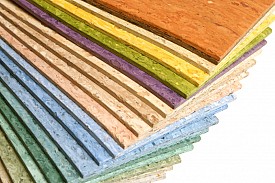
Quick: tell me what you think of when you hear the word "linoleum." Cheap, tacky-looking polyvinyl chloride (PVC) sheeting sprawled across your floors, right? With some ridiculous pattern designed to make it look like something else when we all know it's just another toxin-emitting substance making you, and your home, sick. It's probably one of those things you aim to rip out ASAP during your next remodel.
Would you be surprised to learn that linoleum is actually one of the most ecologically-friendly flooring materials available?
There is, of course, a little catch: we're talking about natural linoleum, which was originally developed in the 1850s. The inventor, Frederick Walton, put two and two together and made linoleum, producing it from recycled materials like minerals, wood and cork dust, and so forth, bound together with linseed oil and pine rosin on a burlap backing. Better yet, you can actually recycle old linoleum to make new linoleum, which is a pretty neat trick!
The resulting product was extremely durable, rather beautiful, even-wearing, smooth, and quite friendly to the environment. Linoleum also helps insulate rooms, and it's very quiet, making it ideal for muffling sound in environments where you don't want noises carrying. Conveniently, the use of natural materials also eliminated potential allergens, an issue for people with sensitivities to construction materials and plastics.
His linoleum was made with recycled materials, and it didn't produce any dangerous offgassing or involve the use of harmful chemicals. With the development of a PVC substitute, however, it fell out of favor. For one thing, it was quite expensive, which made it challenging for homeowners to install, and for another, PVC tended to be more fire-resistant, a concern for many contractors.
Even with that precaution, though, linoleum can be a fantastic ecologically-friendly flooring choice. Just take some care in your research and purchasing decisions. Make sure to browse real natural linoleum, not PVC flooring options, and discuss installation options with a flooring specialist. One option involves adhesives, which can introduce harmful chemicals into your homes. Other linoleum products come in the form of tongue and groove tiles which can be snapped together to create a floating floor. Not only does this eliminate the need for harsh glues, it also doesn't damage the subfloor.
You can buy linoleum in a range of patterns and colors, offering lots of options in terms of the look and feel of your floor. Your Minneapolis contractor may have a lookbook of floors she's installed to give you an idea of the options available, but be aware that complex designs are more expensive to implement.
When it comes to maintaining linoleum, you want to stick with green cleaning products to protect your investment (and so you don't defeat the purpose of paying a premium for linoleum in the first place). Sweep, vacuum (with the beater bar up so it doesn't scuff), and dust mop regularly to prevent buildups. When you need to mop, use a damp mop and mild soap to clean -- apply jojoba oil afterwards if you need to in order to buff out scuffs and seal the flooring. Eco-friendly floorwaxes are also available for maintenance to protect your floors.





